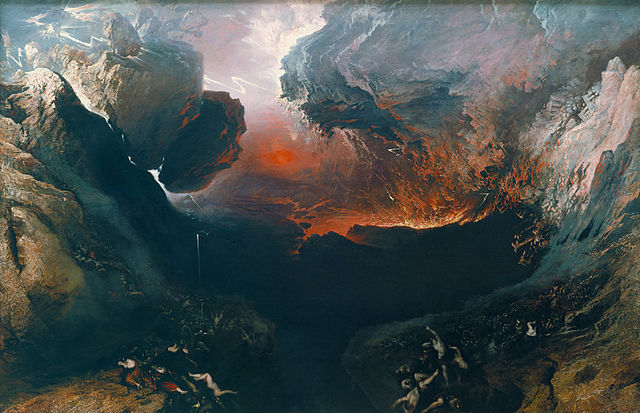Decoding the Apocalypse, Part 2
David Meade (not his real name) believes he has decoded “the Great Sign of the Woman” in Revelation 12—“the most important revelation of the century.” He claims his writings help Christians “understand how the book of Revelation plays out.” According to Meade, October of 2017 corresponded to the Jewish year 5778, which in turn initiated a twelve-month time period that represents the potential unfolding of the seals of the Book of Revelation (chapters 6-8). Along with the mistakes and miscalculations he made in tying his theories about Plant X or Nibiru to astronomy (See “Decoding the Apocalypse, Part 1”), he repeated the interpretive errors others have been making with Biblical prophecy for at least 200 years.
William Miller saw military action at the Battle of Plattsburgh during the War of 1812. One of the many shots fired by the British on the American defenders of the fort exploded two feet from him, wounding three of his men and killing another. Not only did the vastly outnumbered American forces overcome the British at Plattsburgh, Miller survived without a scratch. He considered this to be a miraculous event, and began a gradual rejection of his Deistic faith.
After his conversion to evangelical Christianity, his Deist friends challenged him to justify his newfound faith, so he began a careful study of the Bible. As a result of his studies, Miller became convinced that the date of the Second Coming or Advent of Christ was revealed in Biblical prophecy. Drawing heavily on Daniel 8:14, he believed its reference to the restoration of the sanctuary meant the Earth would be cleansed by fire (destroyed) at the Second Advent of Christ. He also concluded the 2,300 days until the restoration of the temple began with the decree of Artaxerxes I in 457 BC to rebuild Jerusalem. Using the day-age principle, where each of the 2,300 days mentioned in the prophetic verse represented a calendar year, he concluded the Advent of Christ would happen in 1843.
“I was thus brought … to the solemn conclusion, that in about twenty-five years from that time in 1818 all the affairs of our present state would be wound up.” By 1840, what had been an “obscure, regional movement,” became a national movement known as the Millerites, and later as Adventists. Despite two unfulfilled predictions for the Advent of Christ, Miller and his followers persisted in looking for the soon-coming of Christ. The Seventh Day Adventists denomination is an offshoot of the Millerites. See “William Miller (preacher)” and “William Miller” for more information on Miller and his followers. Failing to distinguish between what is known as prophetic and apocalyptic eschatology, Meade, Miller and a variety of others interested in the “end times” have made false claims in their interpretation of apocalyptic passages like Daniel 8:14 and chapter 12 of Revelation.
Before going any further, let’s define some of the important terms in this discussion. Prophecy is an oral, divine message mediated through an individual (or prophet). It can admonish—be either accusatory or exhortatory—or predict—foretell future events. Eschatology is a combination of Greek words meaning “the study of last things.” It includes the study of death, the intermediate state, the afterlife, judgment, the time of Christ’s second coming (or Advent), the millennium (Revelation 20), heaven and hell. So prophetic eschatology refers to a pronouncement about last things.
Apocalyptic is a genre of biblical literature that uses symbolic language to describe God’s actions and coming judgment described within eschatological passages. The term is derived from the Greek word apokalypsis, meaning revelation or unveiling. The Baker Encyclopedia of the Bible made the following distinction between prophetic and apocalyptic eschatology:
In prophetic eschatology, the dominant form in the OT, God is expected to act within history to restore man and nature to the perfect condition, which existed prior to man’s fall. Apocalyptic eschatology, on the other hand, expects God to destroy the old imperfect order before restoring the world to paradise.
In its discussion of the literary genre of apocalypse, the Dictionary of Biblical Imagery pointed out how modern readers are often confused by apocalyptic passages. The imagery and otherworldly experiences “seem bizarre and out of sync with most of Scripture.” Readers who take this literature at face value, as did Meade and Miller, will often try to determine “what will happen when,” and therefore miss the intent of the apocalyptic message. “When read aloud an apocalypse held ancient listeners spellbound with special effects and promise of better days ahead.” The visions of heaven and the future, with extraordinary creatures and events, drew their attention to a whole new world.
There are noticeable patterns of thought and certain characteristics within apocalyptic literature. There is a pattern of dualism between God and Satan; good and evil. Apocalyptic thought was characteristically pessimistic, describing a cosmic catastrophe before the final, decisive victory of God. This led to the contrast between the present evil age and the age to come that “would bring the blessings of the kingdom of God.” There was an imminent expectation of the end of the world, culminating in the ultimate triumph of God and his people over their enemies.
The Baker Encyclopedia of the Bible said: “Many apocalypses contained predictions of the future historical experience of Israel (or of the Christian church), culminating in a final and decisive victory of God and his people.” For example, in the book of Daniel, Nebuchadnezzar’s dream contains a series of foreign empires referred to under the symbolism of the various parts of a gigantic statue. The image was destroyed by the kingdom of God, symbolized by a stone cut without hands from a mountain (Daniel 2:31-45).
One of the characteristics of apocalyptic literature is pseudonymity. With the exception of Daniel and Revelation, the primary examples of apocalypse in the Bible, most surviving extra biblical apocalypses are pseudonymous. The apocryphal book of 1 Enoch, written by a series of unnamed authors between 200 BC and 100 AD, is an example of apocalyptic pseudonymity. Apocalypse is also typically revelation in the form of visions that require an interpreter. “They were recounted in detail and accompanied by an interpretation.” The second half of Daniel (7-12) and all of Revelation are visions. The basic theme of apocalypse is to recount the history of the cosmos from the time of creation until the consummation of that history and the central role of God within its unfolding.
The basic structure of biblical thought is salvation history; apocalypticism characteristically saw salvation history within the context of world history. Salvation history is the distinctive notion, shared by OT and NT authors alike, that God reveals himself through saving acts and revelations during the course of history, particularly the history of his chosen people.
There is also an extensive use of symbolism in apocalypse. When symbolism was used in prophetic visions, it was usually uncomplicated, as in Isaiah 6:6. But “the symbolism of apocalyptic visions was both more complex and more bizarre than that of prophetic visions.” Several scholars have noted how the complexity of symbolism in prophetic visions became almost apocalyptic as the classic prophetic period ended. For example, the symbolism used in the book of Zechariah is borderline apocalyptic. The Dictionary of Biblical Imagery noted where the imagery in the NT might allude to earlier biblical phrases, but those phrases have to be reinterpreted in their NT context. “The imagery in the book of Revelation has many parallels with the books of Ezekiel and Daniel, but individual images cannot be assumed to mean the same in both contexts.” Apocalyptic imagery is fluid and dependent upon the immediate context in which it is used.
So William Miller’s calculation that the end of the world and the return of Christ was coming in 1843, founded upon his understanding of the 2,300 days of Daniel 8:14, was itself a false prophecy. David Meade’s attempts to equate the vision in Revelation 12 to current astronomical, political and social phenomena misses the point of the apocalyptic vision in that chapter. Much of apocalyptic imagery “is like that of our familiar political cartoons in which caricatures and symbolic figures or objects represent people and events on the current scene.” Despite its seeming concreteness, the imagery in apocalyptic writing is fundamentally nonvisual and nonpictorial. “While this literature seems to paint specific pictures, the images are almost impossible to put into composite pictorial form.” So what are you to do when reading apocalyptic passages in the Bible? I suggest you listen to the following advice given in the Dictionary of Biblical Imagery:
The imagery of the genre of apocalypse has probably been subjected to more incorrect interpretation than any other aspect of Scripture. The problem is primarily a matter of distance between the ancient audience and modern interpreters. To bridge that distance the following guidelines are necessary: (1) Read with the ear of an ancient listener. Apocalyptic forms of expression were very common outside the Bible, and contemporary readers need to become familiar with that mindset to understand biblical apocalyptic literature and symbolism. (2) Be sensitive to the setting of crisis. Apocalyptic authors wrote with a flair for the spectacular in an attempt to lift the sights of despairing listeners from their current problems to God’s striking solutions. (3) Expect symbolic language. The events described in apocalyptic literature are often presented with literary techniques found more commonly in poetry: metaphor, hyperbole, personification, irony, numerical patterns and so forth. These special effects allowed apocalyptic to describe heaven and the future with captivating imagery. (4) Consider the oral nature of ancient society. Literature was written to be read aloud or quoted from memory. Listeners came away with an overall impression more like an impressionistic painting than like a photograph in high resolution. Individual details remained a puzzle, but the big picture was clear. (5) Recognize the function of apocalypse. It was a message of hope for the oppressed, a warning to the oppressors and a call to commitment for those unsure of their loyalties.



